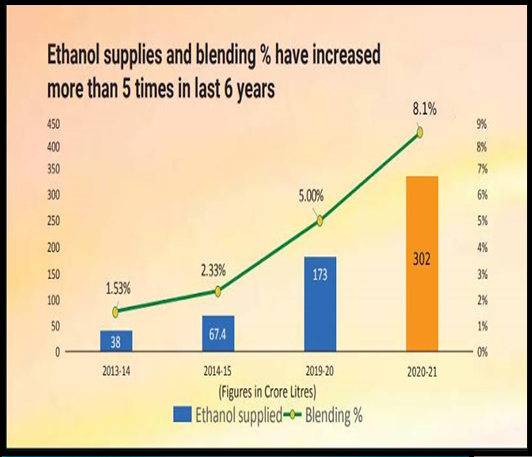GOVERNMENT’S REVERSAL ON SUGARCANE JUICE FOR ETHANOL PRODUCTION
Why in the News?
- Government reverses the ban, allowing the use of sugarcane juice and B-heavy molasses for ethanol.
- Government initially banned the use .
Source : PIB
Highlights:
- Details of Flexibility: Caps the diversion of sugar at 17 lakh tonnes for the 2023-24 supply year (ends October 2024).
- Target: Government aims for 15% ethanol blending with petrol in the 2023-24 supply year.
- Current Scenario: Achieved 12% blending in the 2022-23 supply year.
- Challenges: Challenges include low cane production, recent rains affecting recovery, and drought in Maharashtra and Karnataka.
About Ethanol:
- Ethanol, recognized as ethyl alcohol or grain alcohol, is a transparent, colourless, and inflammable liquid.
- This alcohol variant, denoted by the chemical formula C2H5OH, is widely prevalent and is generated by fermenting sugars from sugarcane juice or B-heavy molasses using yeast or other microorganisms.
Ethanol Blending:
- What? : Ethanol blending is the practice of mixing ethanol, a biofuel produced through organic matter fermentation, with conventional petrol or gasoline.
- Significance : This process enhances fuel efficiency, reduces greenhouse gas emissions, and promotes the use of renewable energy sources in the automotive industry.
Ethanol Blending Programme:
- The Ethanol Blending Programme, initiated by the Indian government in 2003, aims to promote ethanol-blended petrol (EBP) as an eco-friendly alternative to traditional petrol.
- Initially set at 5% ethanol blending (E5), the program later increased the blending ratio to 10% (E10).
- The National Biofuels Policy, introduced in 2018, targets 20% ethanol blending by 2025.
- To encourage ethanol production and EBP use, the government offers incentives like subsidies, tax exemptions, and excise duty waivers.
- Implemented in phases across states, the program achieved nationwide coverage by 2021.
EBP reduces fossil fuel consumption, enhances energy security, lowers carbon emissions, and supports the agricultural sector by creating a market for ethanol feedstocks.

 Source : PIB
Source : PIB

